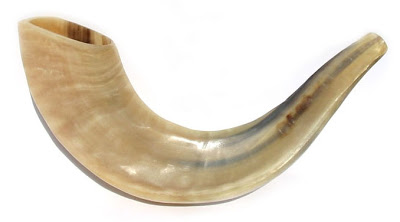from wikipedia.com
 A shofar is an ancient musical horn typically made of a ram's horn, used for Jewish religious purposes. Like the modern bugle, the shofar lacks pitch-altering devices, with all pitch control done by varying the player's embouchure. The shofar is blown in synagogue services on Rosh Hashanah and at the very end of Yom Kippur, and is also blown every weekday morning in the month of Elul running up to Rosh Hashanah. Shofars come in a variety of
sizes and shapes, depending on the choice of animal and level of finish.
The shofar is mentioned frequently in the Hebrew Bible, the Talmud and rabbinic literature. In the first instance, in Exodus 19, the
blast of a shofar emanating from the thick cloud on Mount Sinai makes the Israelites tremble in awe. The shofar was used to announce the new moon and the Jubilee year. The first day of Tishrei (now known as Rosh Hashana) is termed a "memorial of blowing", or "day of blowing", the shofar. Shofars were used for signifying the start of a war. They were also employed in processions as musical accompaniment, and were inserted into the temple orchestra by David.
The shofar was blown in the times of Joshua to help him capture Jericho. As they surrounded the walls, the shofar was blown and the Jews were able to capture the city. The shofar was commonly taken out to war so the troops would know when a battle would begin. The person who would blow the shofar would call out to the
troops from atop a hill. All of the troops were able to hear the call of the shofar from their position because of its distinct sound.
A shofar is an ancient musical horn typically made of a ram's horn, used for Jewish religious purposes. Like the modern bugle, the shofar lacks pitch-altering devices, with all pitch control done by varying the player's embouchure. The shofar is blown in synagogue services on Rosh Hashanah and at the very end of Yom Kippur, and is also blown every weekday morning in the month of Elul running up to Rosh Hashanah. Shofars come in a variety of
sizes and shapes, depending on the choice of animal and level of finish.
The shofar is mentioned frequently in the Hebrew Bible, the Talmud and rabbinic literature. In the first instance, in Exodus 19, the
blast of a shofar emanating from the thick cloud on Mount Sinai makes the Israelites tremble in awe. The shofar was used to announce the new moon and the Jubilee year. The first day of Tishrei (now known as Rosh Hashana) is termed a "memorial of blowing", or "day of blowing", the shofar. Shofars were used for signifying the start of a war. They were also employed in processions as musical accompaniment, and were inserted into the temple orchestra by David.
The shofar was blown in the times of Joshua to help him capture Jericho. As they surrounded the walls, the shofar was blown and the Jews were able to capture the city. The shofar was commonly taken out to war so the troops would know when a battle would begin. The person who would blow the shofar would call out to the
troops from atop a hill. All of the troops were able to hear the call of the shofar from their position because of its distinct sound.